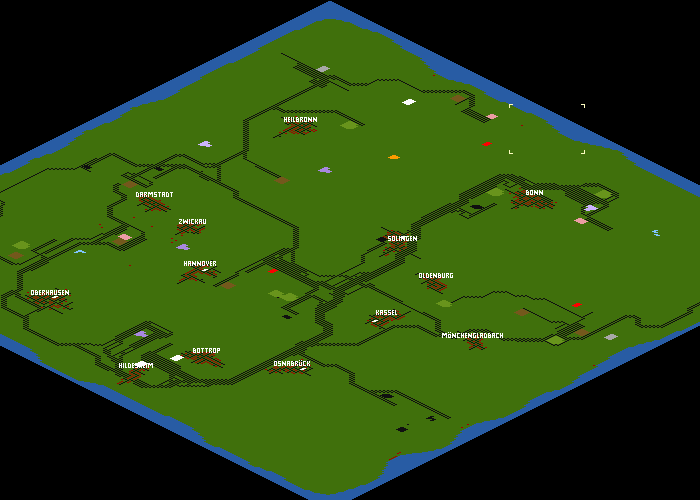Settings
This tutorial shows the development of a transport company starting in the year 1921. This particular game focuses on freight transport on rails, other means of transportation are not used. An additional goal is to focus on a somewhat realistic gameplay, i.e. the track layouts should look more or less like real railways.
The game is based on a random 256x256 map with only a few cities and scarce industries in a hilly terrain. NewGrfs are only used for optical reasons, except for the DBSetXL and the Total Town Replacement set. Only the original industries are used, with the notable addition of an ancient grf that allows using paper as freight also in temperate climate (Download von TTDPatch.net).
Since the tutorial only focuses on a very general gameplay, difficulty settings can be chosen in an almost arbitrary way. However, breakdowns are disabled, since they are far too common in the game. Trains will be serviced in depots regularly (real steam trains need coal and even more water), this will be made sure by appropriate timetables. No other players (especially computer controlled ones) are active, since they would only mess up our game.
Note that I tend to build a lot and especially while pausing the game, since game time already runs quite fast and I want to be able to actually watch the trains on their way. But this is a personal habit, everyone may play as desired.
The first line
After having generated the map and set up so important things like color scheme and company name we pause the game and take a closer look at the overview map. It might be a good idea to take a large screenshot of the map and load it into some drawing program. Now one can simply sketch out a rough track layout without risking to lay tracks in an unnecessary complex and expensive way. Planning the track layout ahead will also save lots of trouble with later extensions and refinements!
Typically the first freight to be transported will be coal. This choice is based on several criteria: Coal transports still make a lot of cash even for slow transport (in contrast to passengers, which have to be transported very fast). One can check this by looking at the freight rate diagrams available in game. The second reason is that power stations do not transport anything, so one can concentrate on simply delivering coal. Later in the game one can then create more complex delivery chains for raw materials (coal, wood, iron ore), secondary materials (paper, steel, ...) and goods.
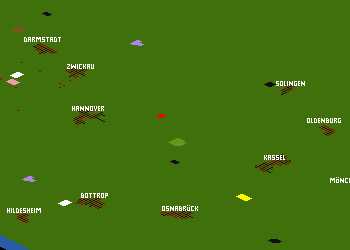 As a starting point we need a suitable coal mine and a power plant. The distance
should not be too large (we need to be able to build the tracks!), but not too
short either (then transports do not make that much money). The map shows a
possible starting area. Since no other power plants can be seen one end of the
line is obvious, and there are several coal mines in a various distances around.
As a starting point we need a suitable coal mine and a power plant. The distance
should not be too large (we need to be able to build the tracks!), but not too
short either (then transports do not make that much money). The map shows a
possible starting area. Since no other power plants can be seen one end of the
line is obvious, and there are several coal mines in a various distances around.
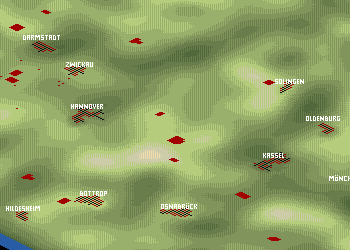 The coal mine closest to the power station is already quite a bit too close
to serve as the first line - the income per delivery would be rather small.
The coal mine near Solingen however looks promising: The distance is neither
too small nor too large and the coal mine is also located on a higher ground
level than the power plant (very important for early lines, since we do not
have powerful engines yet!). Therefore we decide to make this our first line.
The coal mine closest to the power station is already quite a bit too close
to serve as the first line - the income per delivery would be rather small.
The coal mine near Solingen however looks promising: The distance is neither
too small nor too large and the coal mine is also located on a higher ground
level than the power plant (very important for early lines, since we do not
have powerful engines yet!). Therefore we decide to make this our first line.
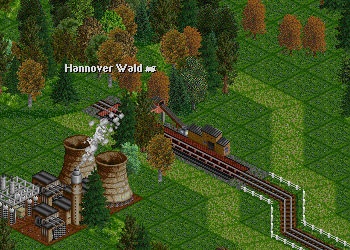 The end point of the line is the unloading station, currently with only one
track. From here a single track leads towards the mine, with only a minor slope
in between. The station is placed one level deeper than the plant, this will
yield more flexibility with later extensions where tracks should not cross each
other if possible.
The end point of the line is the unloading station, currently with only one
track. From here a single track leads towards the mine, with only a minor slope
in between. The station is placed one level deeper than the plant, this will
yield more flexibility with later extensions where tracks should not cross each
other if possible.
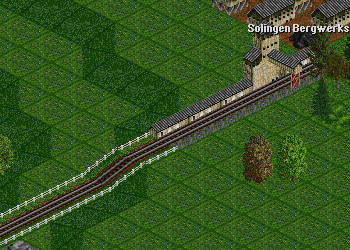 The other end of the line is equally simple, just one track for loading coal. The rest of the line is built in the same simple and cheap way.
The other end of the line is equally simple, just one track for loading coal. The rest of the line is built in the same simple and cheap way.
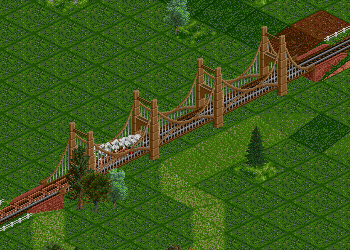 The most expensive part of the track is this bridge required to avoid additional
slopes. This creates an almost flat track except for two slopes that have to be
climbed in order to reach the mine near Solingen. In that direction the trains
are empty, so this should be of no concern.
The most expensive part of the track is this bridge required to avoid additional
slopes. This creates an almost flat track except for two slopes that have to be
climbed in order to reach the mine near Solingen. In that direction the trains
are empty, so this should be of no concern.
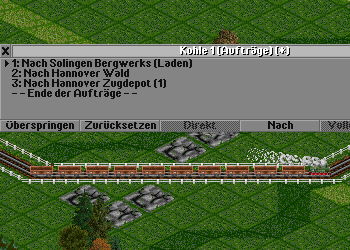 The timetable contains three entries: Full load at the coal mine, travel to the
power station (here the train is automatically unloaded, giving us a hopefully
good profit) and afterwards service at the depot. The latter is a tribute to
reality, as outlined above. This depot order also prevents the train from trying
to get to any other depot if necessary, saving us a lot of trouble later on. In
addition this will also make sure that train will only go to the depot when
empty.
The timetable contains three entries: Full load at the coal mine, travel to the
power station (here the train is automatically unloaded, giving us a hopefully
good profit) and afterwards service at the depot. The latter is a tribute to
reality, as outlined above. This depot order also prevents the train from trying
to get to any other depot if necessary, saving us a lot of trouble later on. In
addition this will also make sure that train will only go to the depot when
empty.
Here we see the length of our first train - nine cars for a total of 150 tons of coal. This is only possible because the tracks leads downhill towards the power plant. With even the shortest climb the train would get stuck immediately - we would need a second engine costing lots of money.
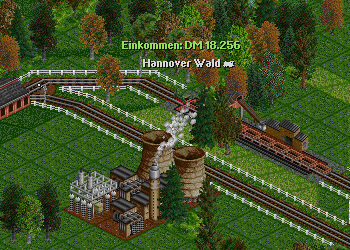 It's done: The first income from coal transportation. Due to the rather short
distance from Hannover the income is not that high. The other train on the line
to Solingen makes nearly twice the money, and we also need a second train on
that line in order to keep up good station ratings. Note that we already
extended the station, read on for the explanation.
It's done: The first income from coal transportation. Due to the rather short
distance from Hannover the income is not that high. The other train on the line
to Solingen makes nearly twice the money, and we also need a second train on
that line in order to keep up good station ratings. Note that we already
extended the station, read on for the explanation.
Adding trains
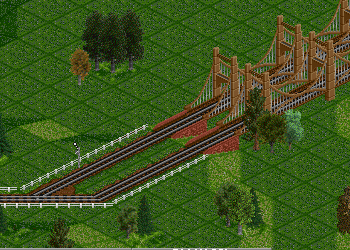 We want to expand the line with as little cost as possible, so that we are able
to use a second train on it. To do that, we create a passing place in the center
between both end points. This passing place needs to be long enough to hold a
full train. A train arriving from the left will go onto the lower track and wait
at the signal until the track to the right is free. This is the very principle shown as example for passing places.
We want to expand the line with as little cost as possible, so that we are able
to use a second train on it. To do that, we create a passing place in the center
between both end points. This passing place needs to be long enough to hold a
full train. A train arriving from the left will go onto the lower track and wait
at the signal until the track to the right is free. This is the very principle shown as example for passing places.
Before the first train has arrived at Solingen we already build the second line towards Hannover. Why is that? Simply because we still had money left after having built the first track and the first train. This means we now have already two trains that can generate income.
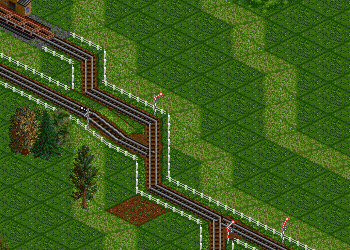 Since we still have money to spend we can already expand the station at the
power plant. The goal is to set up the basic structure of the station in such a
way that it is ready for much more traffic: The trains will leave the station
towards the left and head for the depot, afterwards they will depart on the
track on the higher level. This avoids crossings of the lines. Currently this is
still necessary, but we can change that easily later on.
Since we still have money to spend we can already expand the station at the
power plant. The goal is to set up the basic structure of the station in such a
way that it is ready for much more traffic: The trains will leave the station
towards the left and head for the depot, afterwards they will depart on the
track on the higher level. This avoids crossings of the lines. Currently this is
still necessary, but we can change that easily later on.
The two signals at the bottom belong to the two lines, the right one leads towards Solingen, the other one towards Hannover.
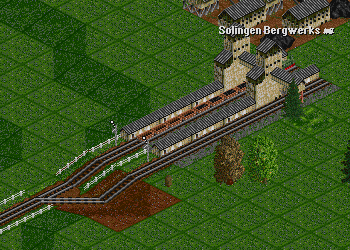 In order to be able to load to trains simultaneously at Solingen, the station is
expanded. This is the last expansion of the track, and we have money left for
one more train.
In order to be able to load to trains simultaneously at Solingen, the station is
expanded. This is the last expansion of the track, and we have money left for
one more train.
The idea is to allow a second train to reach the station while the first one waits until it is fully loaded. The signals are path signals, a train heading for the station reserves the path through the signal directly to a free platform. A train leaving the station can only do that after having reserved a path through the single tracked line behind the signal. If that is not possible it will wait at the signal. This is the standard signalling scheme for single tracked lines.
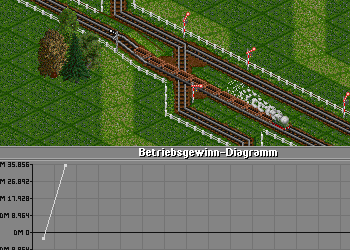 We simply clone the first train and can now use two trains to transport coal
from Solingen. Since the other mine also produces enough coal to fill a second
train we expand the station there as well and build another train. After the end
of the second quarter we own four trains and generate a profit from coal
transport - which is required by now, since the base capital has been spent.
We simply clone the first train and can now use two trains to transport coal
from Solingen. Since the other mine also produces enough coal to fill a second
train we expand the station there as well and build another train. After the end
of the second quarter we own four trains and generate a profit from coal
transport - which is required by now, since the base capital has been spent.
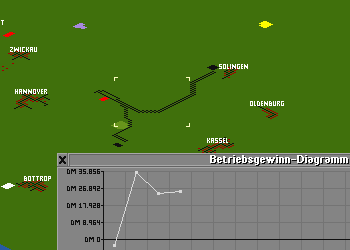 After the first year the line to Solingen is double tracked completely, two
trains serve each mine. Further expansion on this network only is not possible
anymore, we have to create new lines towards other coal mines. Two of them are
located to the south of Kassel. Integrating them into our network will be the
topic of the next section.
After the first year the line to Solingen is double tracked completely, two
trains serve each mine. Further expansion on this network only is not possible
anymore, we have to create new lines towards other coal mines. Two of them are
located to the south of Kassel. Integrating them into our network will be the
topic of the next section.
Network creation
Our initial capital has been invested, we generate a small but steady income, so now we need to check how and where we can expand our network.
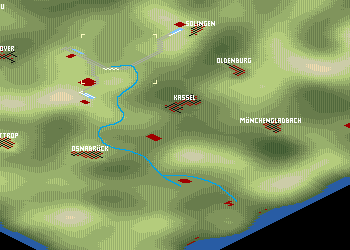 The map shows several coal mines to the South of Kassel and
Mönchengladbach. The terrain is also suitable for our needs: The line
will have several climbs, but with careful planning these can be spread
across the whole line, so that we do not need complex loops. The layout
reference has been painted into the image.
The map shows several coal mines to the South of Kassel and
Mönchengladbach. The terrain is also suitable for our needs: The line
will have several climbs, but with careful planning these can be spread
across the whole line, so that we do not need complex loops. The layout
reference has been painted into the image.
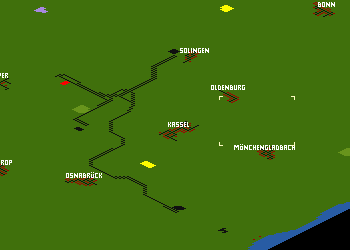 This is how it looks like in early 1923. The line is completed with at least
one track and includes some passing places. Since the line also contains
some climbs towards the power station (the direction of the full trains) we
will need to use two engines for a train, otherwise it would get stuck.
This is how it looks like in early 1923. The line is completed with at least
one track and includes some passing places. Since the line also contains
some climbs towards the power station (the direction of the full trains) we
will need to use two engines for a train, otherwise it would get stuck.
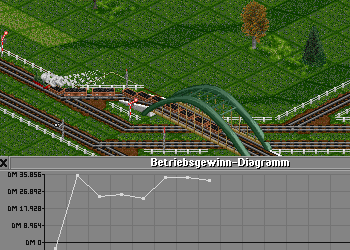 The first two years are over, and the profit chart looks promising. The
first two lines generate a steady income, which does not yet allow for great
leaps, but it saves us from bankruptcy. The new longer line is not yet part
of the chart, since the train is still traveling along. In 1923 we want to
increase our profit, basically by generating more income - so we need more
trains. To allow for them we need to plan more passing places, but we still
focus on new trains rather than more tracks: Tracks are wasted investments
as long as there is no train to use them.
The first two years are over, and the profit chart looks promising. The
first two lines generate a steady income, which does not yet allow for great
leaps, but it saves us from bankruptcy. The new longer line is not yet part
of the chart, since the train is still traveling along. In 1923 we want to
increase our profit, basically by generating more income - so we need more
trains. To allow for them we need to plan more passing places, but we still
focus on new trains rather than more tracks: Tracks are wasted investments
as long as there is no train to use them.
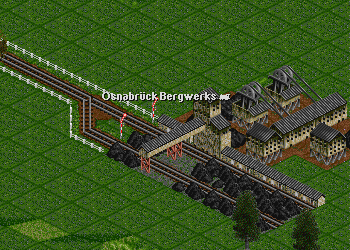 Coal piles up at the station of Osnabrück. We really need to get
more trains onto this line... Passing places have already been built, so we
can buy new trains.
Coal piles up at the station of Osnabrück. We really need to get
more trains onto this line... Passing places have already been built, so we
can buy new trains.
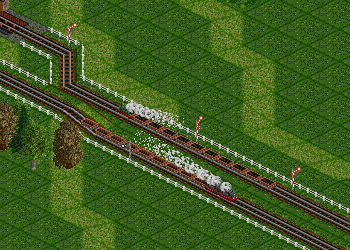 In the spring of 1923 the next train starts its first journey on the line to
Osnabrück. By now new engine types are available, allowing higher top
speeds - the obvious choice for us. Still we need to use two of them per
train. Here two trains meet near the power plant, one of them hauled by the
newer class 75 engines, the other one by the older class 92.
In the spring of 1923 the next train starts its first journey on the line to
Osnabrück. By now new engine types are available, allowing higher top
speeds - the obvious choice for us. Still we need to use two of them per
train. Here two trains meet near the power plant, one of them hauled by the
newer class 75 engines, the other one by the older class 92.
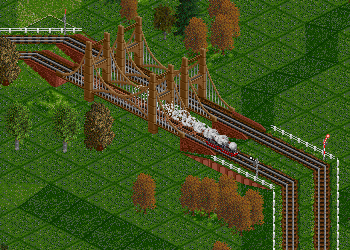 By early 1924 the whole line to Osnabrück is double tracked, with four
trains being in use on the line. Now we can focus on opening a branch line
to the second coal mine.
By early 1924 the whole line to Osnabrück is double tracked, with four
trains being in use on the line. Now we can focus on opening a branch line
to the second coal mine.
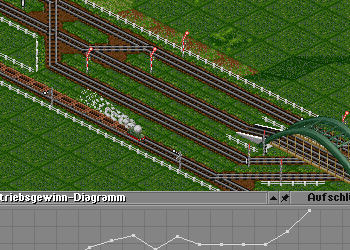 We reach the next coal mine near Mönchengladbach in early 1925. This
line uses the existing line to the mine near Osnabrück. By now the new
class 38 is available, allowing to carry 135 tons of coal with a single
engine. We buy a number of new trains and also expand the unloading station
at the power plant with to have two tracks and a revised entry. The results
of the year are obvious: Our income increases.
We reach the next coal mine near Mönchengladbach in early 1925. This
line uses the existing line to the mine near Osnabrück. By now the new
class 38 is available, allowing to carry 135 tons of coal with a single
engine. We buy a number of new trains and also expand the unloading station
at the power plant with to have two tracks and a revised entry. The results
of the year are obvious: Our income increases.
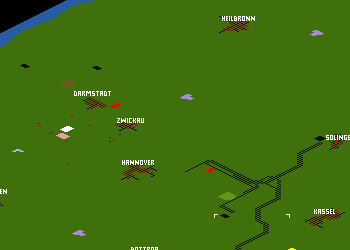 By the start of 1926 all lines are fully double tracked, the only possible
optimization is the use of more trains. Longer trains would be even better,
but we would need stronger engines, which have not yet been developed. Long
story short: We take a look at the map to check where we can expand the
network. There are two coal mines near Darmstadt, these are our goal for
this year.
By the start of 1926 all lines are fully double tracked, the only possible
optimization is the use of more trains. Longer trains would be even better,
but we would need stronger engines, which have not yet been developed. Long
story short: We take a look at the map to check where we can expand the
network. There are two coal mines near Darmstadt, these are our goal for
this year.
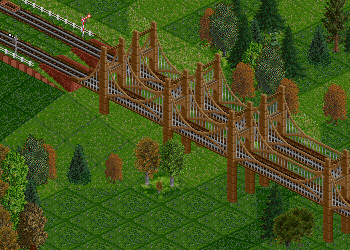 After various ideas about the track layout we have found a nearly optimal
solution. The whole line is completely flat, even though we had to build a
huge bridge to achieve that. The alternative would have been to go around
the valley, but we would still have needed several climbs per valley side.
The bridge was simpler and looks more spectacular.
After various ideas about the track layout we have found a nearly optimal
solution. The whole line is completely flat, even though we had to build a
huge bridge to achieve that. The alternative would have been to go around
the valley, but we would still have needed several climbs per valley side.
The bridge was simpler and looks more spectacular.
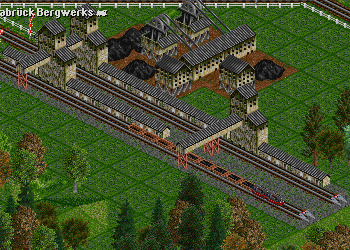 A tribute to reality: New safety regulations demand the use of buffer stops
at the end of a track. While doing that we also lengthen the stations to be
prepared for future developments. The creation of our coal transportation
network is now finished: All coal mines are served, the stations are large
enough for the future. However, the unloading station is at the limit of its
capacity and needs to be adapted, since trains are queueing up.
A tribute to reality: New safety regulations demand the use of buffer stops
at the end of a track. While doing that we also lengthen the stations to be
prepared for future developments. The creation of our coal transportation
network is now finished: All coal mines are served, the stations are large
enough for the future. However, the unloading station is at the limit of its
capacity and needs to be adapted, since trains are queueing up.
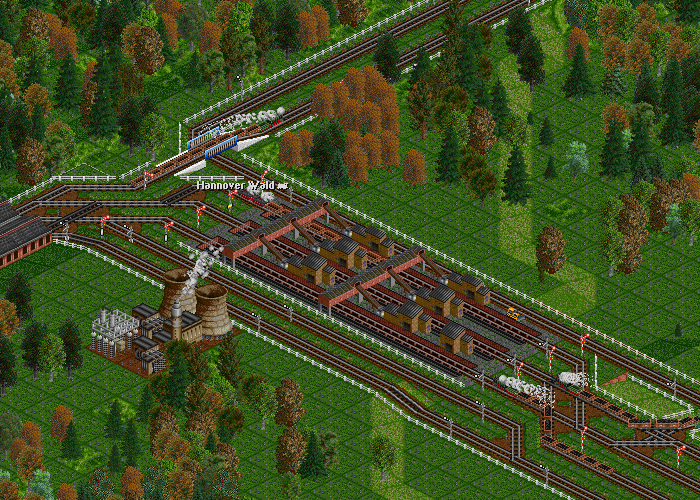
The problems where twofold: The depot behind the station was simply not capable of serving the number of trains running on the network by now. Therefore the depot complex was extended: Trains on the newest line (towards the top right) will use the leftmost depot, all other trains head towards the other one. With the use of path signals two trains can now leave the station towards the depot at the same time to make room for the next trains approaching the station.
When optimizing the departing side of the station, the station entry can be improved as well. And of course one can add a third track to the station. Now two trains can enter the station simultaneously, which is enough for our current needs.
The summary of our first achievements looks like this: Over the course of six years we have built lines to six different coal mines, bought 19 trains and repayed our starting credit completely. The balance sheet looks healthy (income from the trains is about 1 million DM), so we already got several 100.000 DM to spend on new tracks and trains. There are no coal mines left on the map, so we switch to other kinds of freight.
Other freights
Once the company is basically up and running, it is actually pretty irrelevant which freight to choose for the next lines. It simply depends on what is available on the map. If there are many iron ore mines and only few farms, transporting grain and livestock will be rather uninteresting.
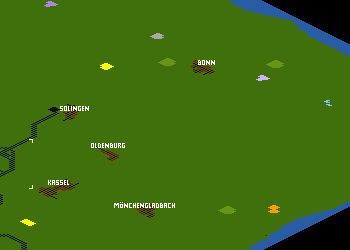 Out map contains five forests, one iron ore mine, two farms and two oil fields.
It should be self-explanatory that we choose wood transportation.
Out map contains five forests, one iron ore mine, two farms and two oil fields.
It should be self-explanatory that we choose wood transportation.
Usually, wood is transported from forests to saw mills that produce goods. These goods are brought into towns. This means you can get an income from two transports originating from one pile of wood. However, as I use a special grf (see the introduction), I have another option as well: I can transport wood to a paper mill, the paper can be transported to the printing works, which then produces goods. This means I have three transports instead of two - sounds much more interesting. So we need to check where there is a paper mill on the map waiting for our trains.
There are two paper mill on the map, and one of them cannot be used, since it is crammed between two towns inside a valley. Since we need to build a lot more tracks near the paper mill as compared with the power station (we need to transport the produced paper!) we will need lots of space around the paper mill.
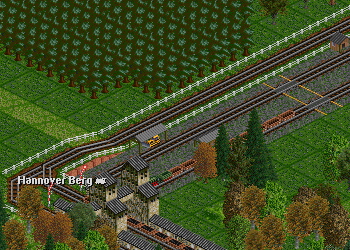 After more than a year of building (local authorities were a bit
uncooperative at first and had to be convinced that railways are cool by
planting loads of trees) the first wood transport is being loaded.
After more than a year of building (local authorities were a bit
uncooperative at first and had to be convinced that railways are cool by
planting loads of trees) the first wood transport is being loaded.
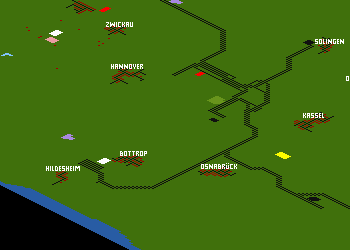 Here you can see the relevant part of the map. The forest is located near
Hannover, the line then uses part of the coal line towards Osnabrück,
before turning onto a completely new line to Bottrop. This new line again is almost flat.
Here you can see the relevant part of the map. The forest is located near
Hannover, the line then uses part of the coal line towards Osnabrück,
before turning onto a completely new line to Bottrop. This new line again is almost flat.
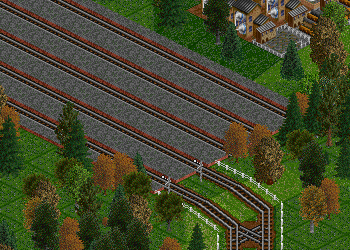 The station at the paper mill still looks a bit unfinished, but this will
change over time. First the local authorities have to be calmed down by lots
of wood trains rolling into the station regularly.
The station at the paper mill still looks a bit unfinished, but this will
change over time. First the local authorities have to be calmed down by lots
of wood trains rolling into the station regularly.
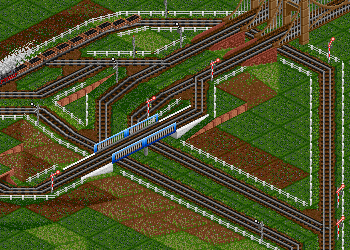 Here we complicate the track combinations near the power station a bit
more... The existing track towards Solingen (the bridges to the right) are
to be used for wood trains. Of course the wood is not to be transported to
the power plant, where the line currently leads to, but onto the other line
towards Osnabrück. Therefore this part of the network is to be
redesigned. Now the wood trains can use the main tracks, the coal trains can
go to the power station (a bit to the left of the picture).
Here we complicate the track combinations near the power station a bit
more... The existing track towards Solingen (the bridges to the right) are
to be used for wood trains. Of course the wood is not to be transported to
the power plant, where the line currently leads to, but onto the other line
towards Osnabrück. Therefore this part of the network is to be
redesigned. Now the wood trains can use the main tracks, the coal trains can
go to the power station (a bit to the left of the picture).
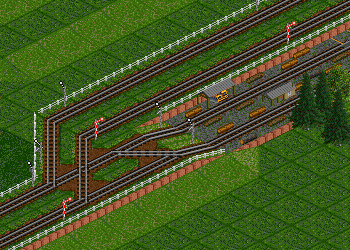 By early 1929 the most important lines have been finished: The line towards
Solingen was extended and leads to two forests near Bonn (see map above).
The image shows the first station, the track next to it leads to the other
forest.
By early 1929 the most important lines have been finished: The line towards
Solingen was extended and leads to two forests near Bonn (see map above).
The image shows the first station, the track next to it leads to the other
forest.
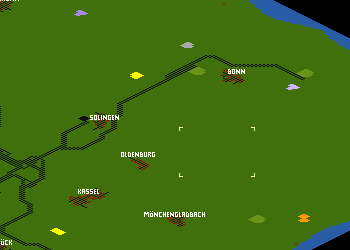 This is what the new line looks like on the map: The two forests near Bonn
are served, and the lines have been double tracked from the very creation,
since money is not that much of a limit anymore
This is what the new line looks like on the map: The two forests near Bonn
are served, and the lines have been double tracked from the very creation,
since money is not that much of a limit anymore
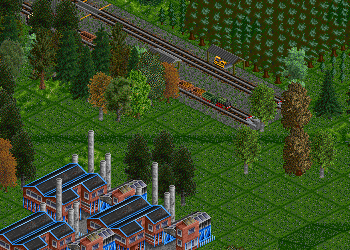 A bit of luck with placing industries is need, but so much luck as can be
seen here is rare indeed. Right next to the forest there is a printing
works. This now means we have a consumer for our paper from the paper mill -
and the line is already existing. This means we can start with some station
extensions immediately.
A bit of luck with placing industries is need, but so much luck as can be
seen here is rare indeed. Right next to the forest there is a printing
works. This now means we have a consumer for our paper from the paper mill -
and the line is already existing. This means we can start with some station
extensions immediately.
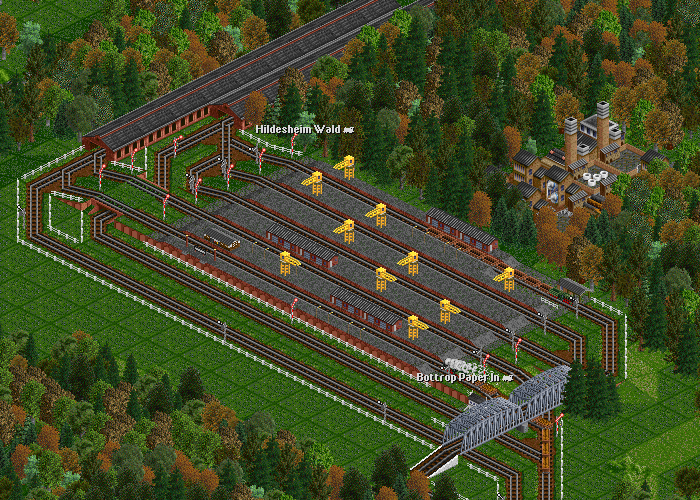
The station at the paper mill has been modified heavily. The wood trains deliver their cargo on the lower two tracks, the other ones are reserved for paper trains. These reach the station via the waypoint Bottrop Paper In and are served at the depot before loading at the station. The freight trains are unloaded and go to the depot afterwards. The picture shows the first paper train waiting for cargo.
While waiting for the paper transport to get going we also check on the coal trains and see that the mine near Mönchengladbach has increased its production drastically, meaning the coal piles up the station. To solve the problem we buy some more trains. In addition there is a new type of wagon available that has more capacity and a much higher top speed - until now trains were crawling at a top speed of only 60 kph. This also means we can finally retire the old class 92 which is still in use on the oldest coal lines.
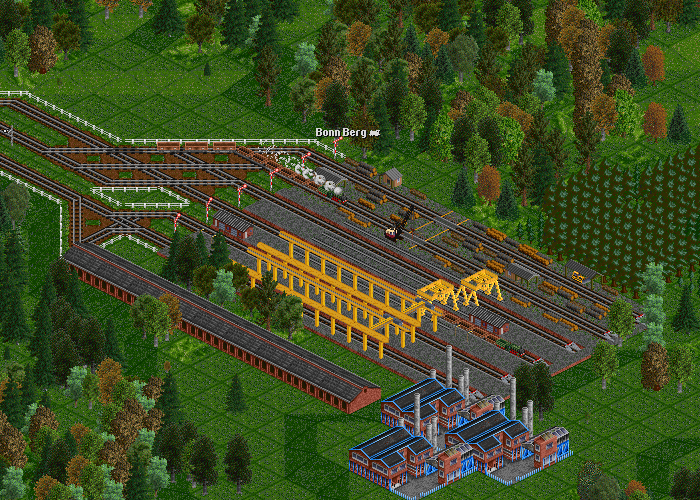
The delivery station for paper has been changed drastically until 1930. The two tracks for wood are still there, but there are two new tracks for paper delivery and two yet unusued tracks for goods trains. Before starting to use them we need to check out where to deliver the goods. The trains are routed into the station by using signal restrictions, which means the trains only "see" the tracks relavant for them. As this feature is not available in OpenTTD, one would need to use waypoints to direct the trains into the station.
Electrification
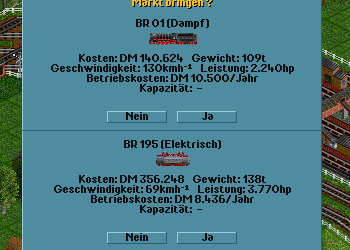 Industry has finally heard our cries for stronger engines in 1930. The steam
engines just cannot cope with the amount of cargo to transport, and the huge
number of short trains clogs the network. So we are eagerly waiting for the
first testing units. The class 01 is an express engine and completely
irrelevant for freight transportation since it does not have the power to
haul a heavy train up a hill. The electric class 195 however has plenty of
power for even the heaviest trains.
Industry has finally heard our cries for stronger engines in 1930. The steam
engines just cannot cope with the amount of cargo to transport, and the huge
number of short trains clogs the network. So we are eagerly waiting for the
first testing units. The class 01 is an express engine and completely
irrelevant for freight transportation since it does not have the power to
haul a heavy train up a hill. The electric class 195 however has plenty of
power for even the heaviest trains.
The most important question now is: Which line to electrify? Currently the main transportation axis with the paper and wood trains seems an obvious choice, with about a dozen trains using it. After having finished that line we can check which other lines can be updated with little effort.
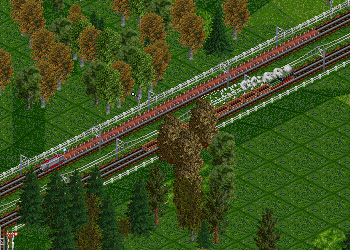 And so electrification leads to a considerable decrease of our monetary
reserves: One engine of class 195 costs only about eight times as much as a
class 38... However the increased power and tractive effort easily outweighs
this problem. Here we see two trains being hauled by the two types of engine - a
class 195 hauls 400 tons, a class 38 only 135 tons at a lower pace due to the
top speed restrictions of the older wagons.
And so electrification leads to a considerable decrease of our monetary
reserves: One engine of class 195 costs only about eight times as much as a
class 38... However the increased power and tractive effort easily outweighs
this problem. Here we see two trains being hauled by the two types of engine - a
class 195 hauls 400 tons, a class 38 only 135 tons at a lower pace due to the
top speed restrictions of the older wagons.
The first trains belong to the paper route that is only in the process of being set up for the first time. Since there are three forests along that line, these trains are the next candidates for an electrification.
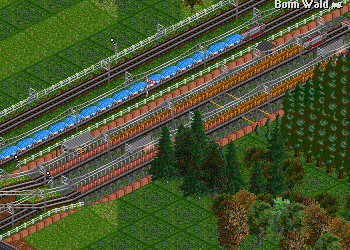 By summer of 1933 all wood trains are hauled by electric engines. As a nice side
effect of the higher capacities we can reduce the number of trains on the
network.
By summer of 1933 all wood trains are hauled by electric engines. As a nice side
effect of the higher capacities we can reduce the number of trains on the
network.
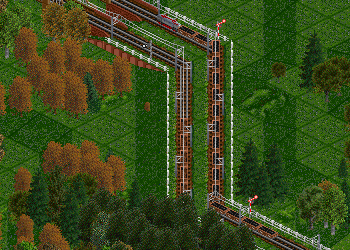 The next goal for electrification is an upgrade of the coal trains, especially
to get rid of the outdated class 75, but also to replace class 38 which
struggles heavily with the few climbs on the network. This takes some time which
also gives us some money reserves for later. It takes until 1935 to get the
trains upgraded, only then we can think about new network expansion plans.
The next goal for electrification is an upgrade of the coal trains, especially
to get rid of the outdated class 75, but also to replace class 38 which
struggles heavily with the few climbs on the network. This takes some time which
also gives us some money reserves for later. It takes until 1935 to get the
trains upgraded, only then we can think about new network expansion plans.
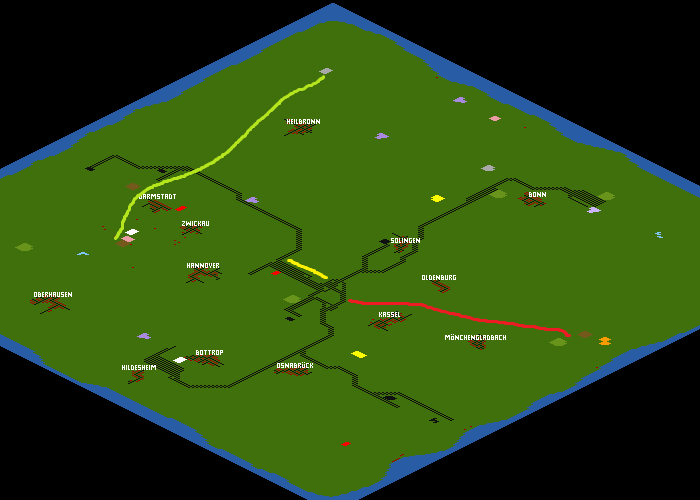
The map shows the next plans for new lines on the network: We start transporting iron ore. This plan consists of two steps: The first line (shown in green) will connect two ore mines to the steel mill. There a big station with depot complex will be built, similar to the one near the paper mill.
The second step is an extension of the lines near the power plant (marked yellow). Here trains will have to pass by the plant in both directions. This will allow the third step (marked red) consisting of a connection of the eastern forest and mine. Trains will have to be able to get on the lines towards the paper mill as well as the steel works.
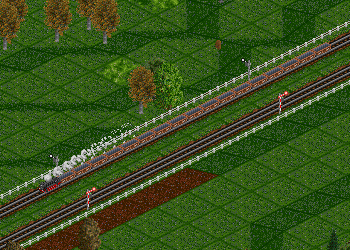 Taking a look at the terrain easily reveals that the first track can be built
almost completely flat, except for one valley that is to be curved around. For
this reason we do not build overhead catenary, but rely on the new steam engines
of class 85 instead. It is a bit faster than the class 195 and allows one more
ore hopper due to its compact design. Finally one can get three of them for the
price of one class 195.
Taking a look at the terrain easily reveals that the first track can be built
almost completely flat, except for one valley that is to be curved around. For
this reason we do not build overhead catenary, but rely on the new steam engines
of class 85 instead. It is a bit faster than the class 195 and allows one more
ore hopper due to its compact design. Finally one can get three of them for the
price of one class 195.
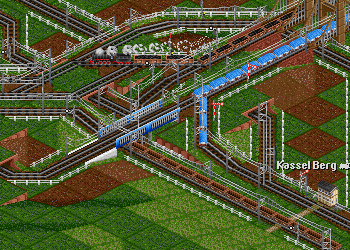 The second part of the network expansion is very small in size, but still quite
a challenge due to the number of tracks and crossings in the area. The result
can be seen in the picture. The main line splits here, leading from the waypoint
Kassel Berg towards Solingen (this is where the paper train is going to), and
also goes on to the top left, passing the power plant. In OpenTTD one cannot
build on tunnel portals, the solution shown here could therefore not be built in
such a compact way.
The second part of the network expansion is very small in size, but still quite
a challenge due to the number of tracks and crossings in the area. The result
can be seen in the picture. The main line splits here, leading from the waypoint
Kassel Berg towards Solingen (this is where the paper train is going to), and
also goes on to the top left, passing the power plant. In OpenTTD one cannot
build on tunnel portals, the solution shown here could therefore not be built in
such a compact way.
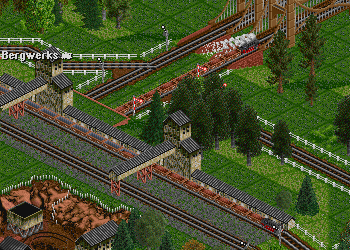 This is the first ore loading station. Beneath it one can see the tunnel of the
line extension towards the second mine. The station is on top of a hill which
yields a better acceleration for leaving trains.
This is the first ore loading station. Beneath it one can see the tunnel of the
line extension towards the second mine. The station is on top of a hill which
yields a better acceleration for leaving trains.
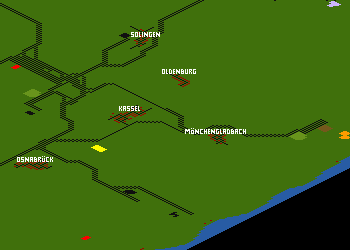 In early 1937 the network looks like this. The planned tracks for ore transport
have been build and are in use. In order to connect the eastern ore mine to the
network, two branch lines were created which go around Kassel on either side.
The reason for this is that the area between Kassel and Osnabrück is not
suited for a complex junction that would have allowed all required connections
without steep climbs. Since these branch lines are only used by two trains each,
a single track is sufficient.
In early 1937 the network looks like this. The planned tracks for ore transport
have been build and are in use. In order to connect the eastern ore mine to the
network, two branch lines were created which go around Kassel on either side.
The reason for this is that the area between Kassel and Osnabrück is not
suited for a complex junction that would have allowed all required connections
without steep climbs. Since these branch lines are only used by two trains each,
a single track is sufficient.
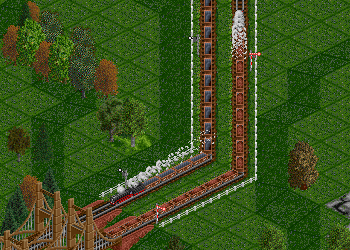 First tests quickly reveal that the class 85 is not capable of hauling these
heavy trains: It does not get stuck at climbs, but it barely reaches 60 kph, a
lot less than expected. We therefore replace them with the newer class 45 that
has a lot more power to get an acceptable top speed. Since the engines of class 85
have only been bought they will not be retired, but will replace the older class
38 on smaller coal trains.
First tests quickly reveal that the class 85 is not capable of hauling these
heavy trains: It does not get stuck at climbs, but it barely reaches 60 kph, a
lot less than expected. We therefore replace them with the newer class 45 that
has a lot more power to get an acceptable top speed. Since the engines of class 85
have only been bought they will not be retired, but will replace the older class
38 on smaller coal trains.
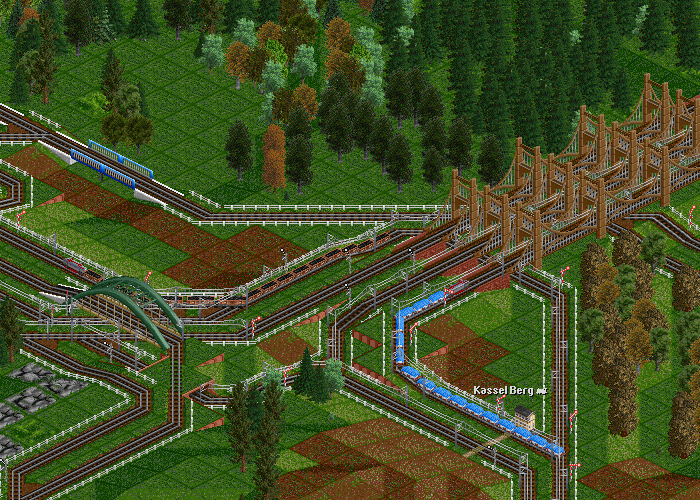
The central hub in our network, the area near the power plant, is getting more and more of a bottleneck. The important lines for wood and paper cross the lines for coal here. Traffic will increase even more with goods trains from the printing works and steel from the steel mill. As a preparation we have to rebuild the tracks in this area almost completely: The barely used line from East to West (only two iron ore trains use it) is moved. In the picture this is the unelectrified track below the bridges. This yields lots of space for changes of the main line: The old bridges are demolished, with new replacements further to the Southeast. This removes some turns on the main line and creates a simpler connection to the power station. The next picture shows the results: The main line has less climbs and curves and there is more room for additional tracks. One could have build it that way 15 years earlier, but back then we did not have the money for such a huge project.
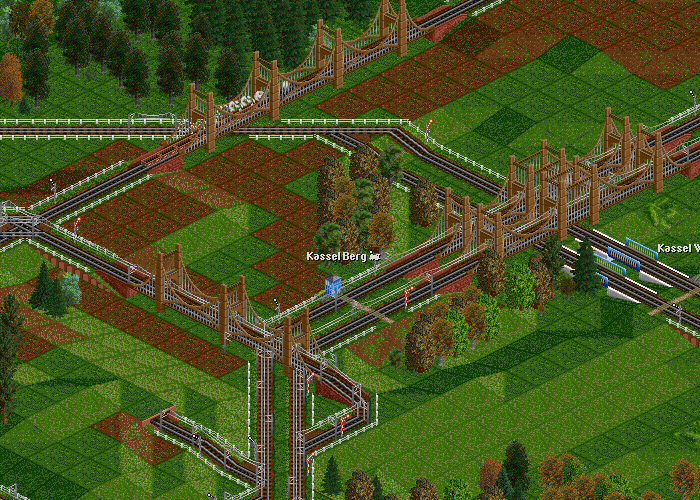
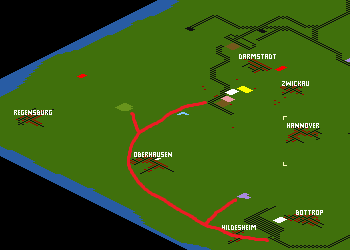 In early 1940 the next step is planned for the network: A connection that closes
the gap between the ore mines in the North and the paper mill in the West. Along
this line there are several farms and a forest, and of course there is a factory
that will accept steel, grain and livestock.
In early 1940 the next step is planned for the network: A connection that closes
the gap between the ore mines in the North and the paper mill in the West. Along
this line there are several farms and a forest, and of course there is a factory
that will accept steel, grain and livestock.
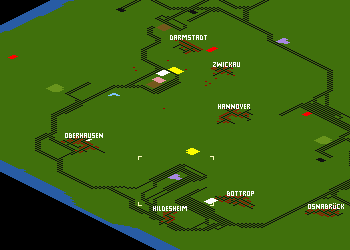 After more than two years of building activity the networks has changed quite a
bit: The planned line has been created, the forest and a farm have also been
connected to it. Lots of tracks have been build around the factory, to serve it
with raw materials and to transport goods from there. The last detail is a
station near Oberhausen which accepts the goods from the printing works on the
other side of the map. A close inspection also reveals minor changes to the
connection of the paper mill near Bottrop was changed a bit, as trains queued up
there.
After more than two years of building activity the networks has changed quite a
bit: The planned line has been created, the forest and a farm have also been
connected to it. Lots of tracks have been build around the factory, to serve it
with raw materials and to transport goods from there. The last detail is a
station near Oberhausen which accepts the goods from the printing works on the
other side of the map. A close inspection also reveals minor changes to the
connection of the paper mill near Bottrop was changed a bit, as trains queued up
there.
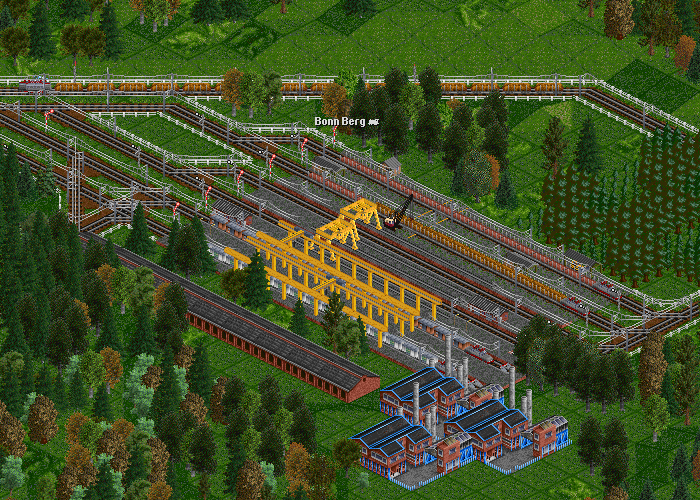
On the other side of the map the station near the printing works was expanded a lot as well. This was necessary due to a dramatic increase in production of the forest, which led to more traffic. The wood trains use the two tracks to the right, then there are two tracks for paper deliveries to the printing works, and finally two tracks for goods that are loaded here and head towards Oberhausen.
The goods trains are equipped with newest engines available: The class E94 is as powerful as the older E95, but is much faster and also outperforms the steam engines of class 45.
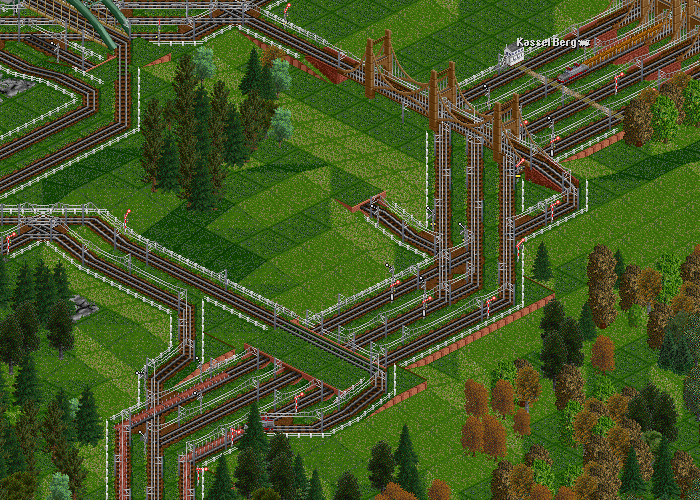
The heavily trafficked main line between the printing works and the paper mill is becoming a bottleneck: Now there are also goods trains that use it from the printing works and Oberhausen, and some parts of the line also see heavy traffic with coal trains. Since this leads to more and more problems, the line is going to be expanded with additional tracks from 1942 onwards. The plan is to have two tracks per direction, the image shows an intermediate result, the expansion is done without stopping the trains on the line. Signals are placed in such a way that trains can freely choose between the tracks for their direction, they can change tracks in regular intervals.
There were some comments on possible improvements regarding the last screenshot. It was argumented that the curves were very tight in some spots, causing trains to slow down. This is correct, as far as OpenTTD is concerned, where curves are much more of a problem compared to TTDPatch. Therefore you can take a look at a comparison image that tries to use smoother curves (Note: building on tunnel portals is not supported in OpenTTD!).
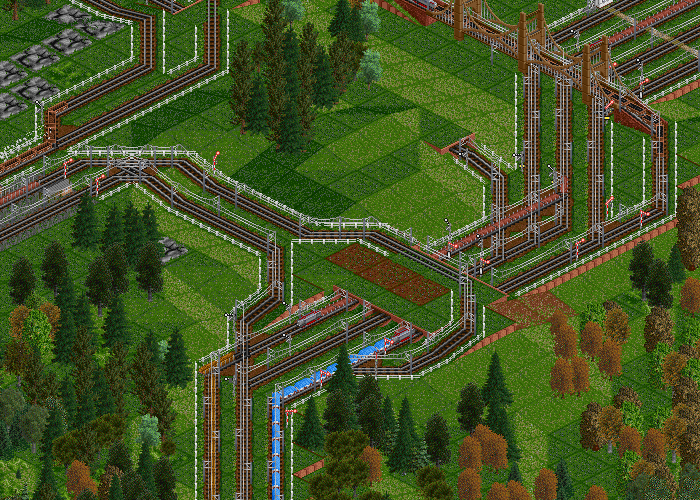
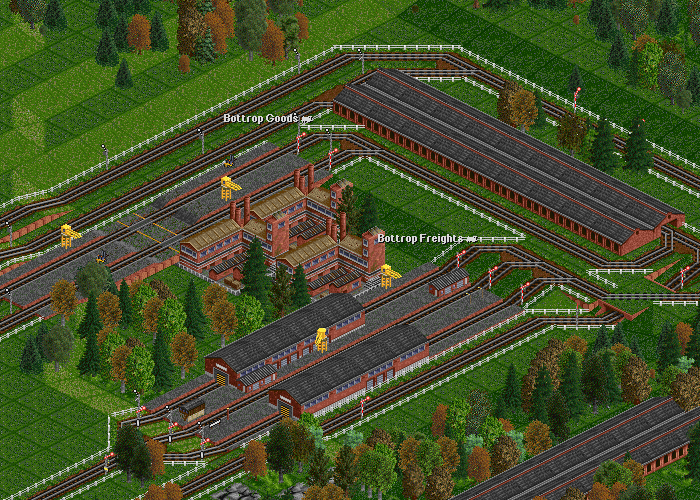
The completely new goods complex near Bottrop was built between 1941 and the summer of 1942. Delivery trains stop at Bottrop Freights, turn around the depot area in counterclockwise direction leave towards the main line, with a possible stop at the service depot. Goods trains that transport the goods from here are serviced first and are then loaded at Bottrop Goods before leaving for the main line (which has to be upgraded once more to prevent traffic blocks). It is planned to have the goods delivered to Bonn, near the printing works on the other end of the map.
One could now make the trains ply between printing works and factory, as the destination stations Bonn and Oberhausen are quite near the respective industries. However, it is very difficult to get the trains balanced without having goods waiting at one station and trains waiting at the other one. For this reason a simple standard timetable is used with the trains returning empty to their industry.
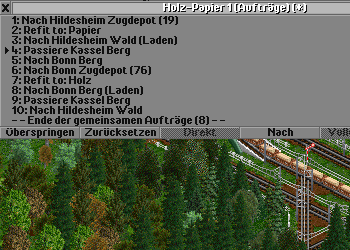 Around 1944 the time tables were changed for the wood and paper transports.
Trains that bring wood from Bonn to the paper mill, and paper trains heading
back towards the printing works near Bonn now use one common timetable. They
head towards a depot at Bonn, where they are refitted to carry wood. After they
have carried the wood to the paper mill, they are refitted to carry paper for
the return journey. This reduces the load on the main line.
Around 1944 the time tables were changed for the wood and paper transports.
Trains that bring wood from Bonn to the paper mill, and paper trains heading
back towards the printing works near Bonn now use one common timetable. They
head towards a depot at Bonn, where they are refitted to carry wood. After they
have carried the wood to the paper mill, they are refitted to carry paper for
the return journey. This reduces the load on the main line.
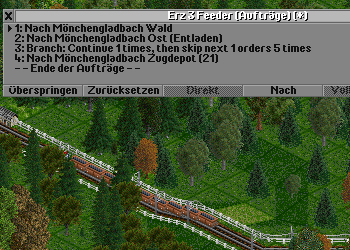 In the late 1940s a new iron ore mine was opened, located near another one that
is already served. Therefore a small branch line was built, so that the ore can
be transferred to the existing station, from where trains head towards the steel
mill. The time table for one such so called feeder train can be seen in the
picture. Since the line is very short, trains do not enter the depot on every
journey.
In the late 1940s a new iron ore mine was opened, located near another one that
is already served. Therefore a small branch line was built, so that the ore can
be transferred to the existing station, from where trains head towards the steel
mill. The time table for one such so called feeder train can be seen in the
picture. Since the line is very short, trains do not enter the depot on every
journey.
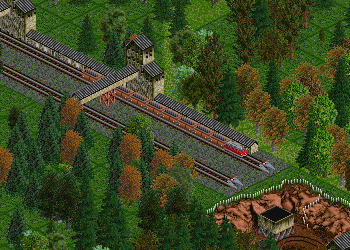 The early 1950s see the first diesel engine on our network: Another ore mine was
opened. Since the lines around the steel mill are not yet electrified, but the
older steam engines are outdated and not available anymore, we try an engine of
class V200. Originally this is a design for express class trains, but we have no
better choice right now.
The early 1950s see the first diesel engine on our network: Another ore mine was
opened. Since the lines around the steel mill are not yet electrified, but the
older steam engines are outdated and not available anymore, we try an engine of
class V200. Originally this is a design for express class trains, but we have no
better choice right now.
By the end of the 1950s the first standard electric engines of class 140 and 150 are available. This marks the start of the full electrification of the network, mainly the tracks between steel mill and factory and some branch lines to iron ore mines. As a result the steam engines will be sidelined, and due to newer and larger wagons our transport capacities increase (which the old steamers would not be able to handle anyway).
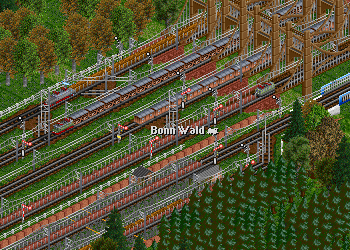 It takes almost ten years to complete the upgrades. Except for a short branch
line the whole network is electrified, with trains being hauled mainly by
classes 194, 140 and 150. Top speed of the trains varies between 80 and 110 kph,
depending on the wagons. Here various freight trains can be seen on the main
line between printing works and paper mill.
It takes almost ten years to complete the upgrades. Except for a short branch
line the whole network is electrified, with trains being hauled mainly by
classes 194, 140 and 150. Top speed of the trains varies between 80 and 110 kph,
depending on the wagons. Here various freight trains can be seen on the main
line between printing works and paper mill.
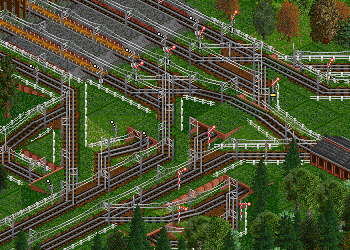 Increasing traffic around the steel mill, caused by more ore transports, but
also to network expansions to nearby farms required a huge modification of the
tracks around the steel mill. This was done during the phase of electrification
and aimed for less blocking of the various train lines.
Increasing traffic around the steel mill, caused by more ore transports, but
also to network expansions to nearby farms required a huge modification of the
tracks around the steel mill. This was done during the phase of electrification
and aimed for less blocking of the various train lines.
Modernization
After the full electrification of the network, focus changes towards fleet management. All lines have been upgraded to suit our needs, new lines are not required, except for short branches to new industries. On the other hand, new engines, both faster and stronger become available. This means faster transport of more cargo, which in turn generates more money.
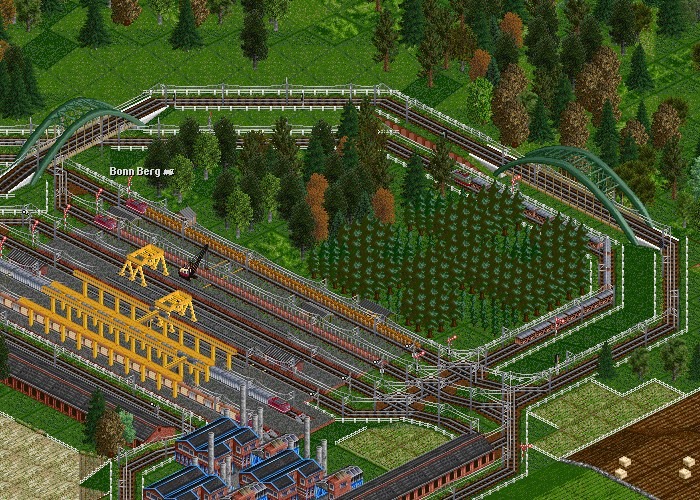
Here you can see the result of another station upgrade near the printing works. The many wood trains caused endless jams on the main line, so in the late 1970s we modified the tracks around the station once again. In the station a number of modern freight trains are being loaded, all being hauled by a modern "energy container" of class 250. With its tractive effort and comparably high top speed this is the universal weapon for any freight transport and replaces all older classes.
Replacements of engines are done as follows: The new units of class 250 replace the older class 150 in heaviest coal and ore transporting duties. This is simply because these trains are struggling most with any climbs. The additional power is quite welcome here. However, since the class 150 has only reached half its lifetime, the units are not scrapped, but replace the even older units of class 194. While these have not reached the end of their lifetime either, they can only reach 90 kph and do not have enough tractive effort for heaviest trains.
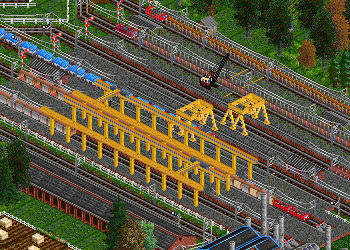 The first wave of train replacements is done by the early 1980s, and with all
engines now having more than enough power top speed becomes more of an issue.
Newest wagons allow freight transports with 140 or even 160 kph, so we need to
use fitting engines like the new class 120 that reaches up to 200 kph (which is
not required here). However, in order to reach that speed with a heavy freight
train we still need to introduce double traction.
The first wave of train replacements is done by the early 1980s, and with all
engines now having more than enough power top speed becomes more of an issue.
Newest wagons allow freight transports with 140 or even 160 kph, so we need to
use fitting engines like the new class 120 that reaches up to 200 kph (which is
not required here). However, in order to reach that speed with a heavy freight
train we still need to introduce double traction.
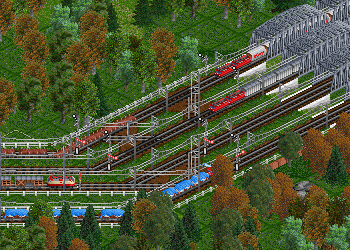 Modernization of the whole fleet takes us into the late 1990s. With the
introduction of bulk freight wagons capable of running at 120 kph even the heavy
coal and ore trains require double traction to keep a useful average speed
without blocking other traffic. The first standard electric engines of class 140
are sidelined, as they are simply too weak for the higher demands. They are
replaced with class 250 or 120. At the end of the modernization, only these two
classes remain, with half a dozen diesel engines of class 232 serving on the
last unelectrified branch lines.
Modernization of the whole fleet takes us into the late 1990s. With the
introduction of bulk freight wagons capable of running at 120 kph even the heavy
coal and ore trains require double traction to keep a useful average speed
without blocking other traffic. The first standard electric engines of class 140
are sidelined, as they are simply too weak for the higher demands. They are
replaced with class 250 or 120. At the end of the modernization, only these two
classes remain, with half a dozen diesel engines of class 232 serving on the
last unelectrified branch lines.
This leads us to the end of the tutorial in 2000 - the company owns about 100 trains and makes several millions per quarter. And all this started with a single coal line 80 years ago. The network that has been created since can be seen in the screenshot.
